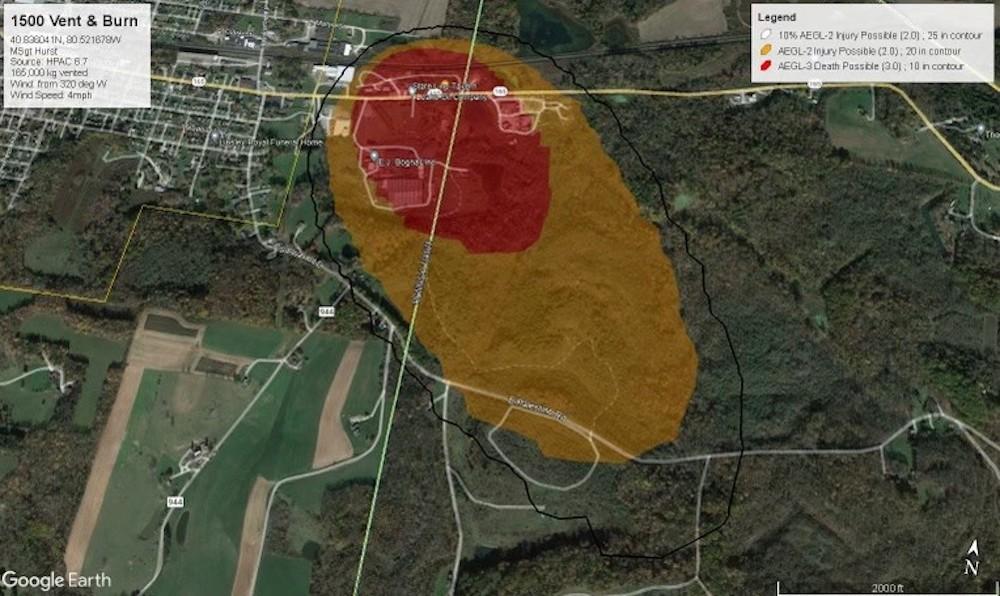Ohio Train Derailment: The Long-Term Impact Of Toxic Chemical Exposure

Table of Contents
Immediate and Short-Term Health Effects
The immediate aftermath of the Ohio train derailment saw a surge in reports of various health issues among residents in the surrounding areas. Exposure to the toxic chemical plume resulted in a range of symptoms, highlighting the immediate and acute health impacts of the disaster. These short-term health effects served as a stark warning of the potential for more serious, long-term consequences.
-
Specific symptoms experienced by residents: Many residents reported experiencing respiratory problems, including coughing, shortness of breath, and wheezing. Others suffered from headaches, nausea, vomiting, skin irritation, and eye irritation. The severity of symptoms varied depending on proximity to the derailment site and duration of exposure.
-
Number of individuals seeking medical attention: Local hospitals saw a significant increase in the number of patients seeking medical attention in the days following the derailment, further illustrating the widespread impact of the toxic chemical release. Precise figures are still being compiled, but reports indicate a substantial number of individuals required medical care.
-
Initial governmental response to the health crisis: The initial governmental response focused on evacuation and immediate medical treatment for those directly affected. However, concerns remain regarding the long-term monitoring and support needed for those who experienced exposure. The adequacy and scope of the initial response continue to be debated and scrutinized.
Long-Term Health Concerns from Vinyl Chloride Exposure
Among the most concerning chemicals released in the Ohio train derailment was vinyl chloride, a known human carcinogen. Exposure to vinyl chloride, even at low levels, carries significant long-term health risks. The potential for delayed-onset health problems following exposure to vinyl chloride adds a layer of complexity to the already concerning situation.
-
Explanation of vinyl chloride's long-term health risks: Vinyl chloride is linked to an increased risk of various cancers, including liver cancer, brain cancer, and lung cancer. It can also cause liver damage, circulatory problems, and other severe health issues. The long latency period before the manifestation of these diseases makes long-term monitoring crucial.
-
Potential for delayed-onset health problems: The insidious nature of vinyl chloride exposure lies in the potential for delayed onset of health problems. Years, or even decades, may pass before individuals exposed to vinyl chloride develop related illnesses. This makes ongoing health surveillance and monitoring of the affected population paramount.
-
Lack of long-term studies on vinyl chloride exposure at this scale: The scale of vinyl chloride release in the Ohio train derailment is unprecedented. The lack of extensive long-term studies on the effects of such high-level exposure makes predicting the full extent of future health consequences challenging.
Environmental Contamination and its Lasting Impacts
The Ohio train derailment resulted in significant environmental contamination, affecting soil, water, and air quality in the surrounding region. The spilled chemicals pose a severe threat to the environment, with long-lasting consequences for both wildlife and human health.
-
Types of chemicals that contaminated the environment: Besides vinyl chloride, other hazardous chemicals, such as butyl acrylate and ethylene glycol monobutyl ether, were released, further complicating cleanup and remediation efforts. The diverse nature of these pollutants adds to the complexity of assessing and mitigating long-term environmental damage.
-
The extent of the environmental damage: The extent of the environmental damage is still being assessed, but early findings suggest contamination of soil, water bodies, and potentially the air. The long-term implications for wildlife, plant life, and the overall ecosystem remain a critical concern.
-
Long-term ecological effects on wildlife and plant life: The impact on the local ecosystem is likely to be profound and long-lasting. The potential for bioaccumulation of toxins in the food chain presents a significant threat to wildlife populations. The restoration of the affected environment will require extensive and prolonged efforts.
-
Challenges in cleanup and remediation efforts: Cleaning up the contaminated area presents significant logistical and technological challenges. The extent of the contamination and the complex nature of the spilled chemicals make complete remediation a long and arduous process.
The Impact on Agriculture and Food Security
The environmental contamination from the Ohio train derailment poses a serious threat to agriculture and food security in the affected region. The potential for long-term impacts on agricultural production and the safety of locally grown food needs to be carefully considered.
-
Potential for chemical leaching into groundwater used for irrigation: The spilled chemicals could leach into groundwater sources used for irrigation, contaminating agricultural products and potentially entering the human food chain. This poses a considerable risk to food safety and security.
-
Impact on livestock and agricultural yields: Exposure to contaminated soil and water could adversely affect livestock health and agricultural yields, leading to economic losses for farmers and impacting food availability.
-
Concerns about the safety of locally produced food: Concerns remain regarding the safety of locally produced food, necessitating rigorous testing and monitoring of agricultural products to ensure their safety for consumption.
The Socioeconomic Impact of the Derailment
Beyond the immediate health and environmental consequences, the Ohio train derailment has had a significant socioeconomic impact on the affected communities. The long-term financial and psychological burdens on residents and the local economy must be addressed.
-
Loss of livelihoods due to business closures or agricultural losses: Businesses in the affected area have experienced closures, and agricultural losses have led to significant economic hardship for many residents. The disruption to livelihoods has created immense financial strain on families.
-
Property devaluation: Property values in the affected areas have likely decreased, leading to further economic hardship for residents. The perception of environmental contamination often negatively impacts property values, causing long-term financial consequences.
-
The psychological toll on residents: The stress and uncertainty surrounding the derailment and its long-term consequences have taken a significant psychological toll on residents. Access to mental health services and support is crucial for the affected communities.
-
Long-term financial burden on individuals and the government: The long-term financial burden of cleanup, medical care, and economic recovery will likely fall on both individuals and the government, representing a substantial economic challenge.
Conclusion
The Ohio train derailment presents a complex and evolving situation with potentially devastating long-term consequences for human health and the environment. The immediate health concerns are only the tip of the iceberg; the long-term impacts of vinyl chloride and other toxic chemicals remain largely unknown, necessitating comprehensive monitoring and research. The environmental contamination and socioeconomic consequences will be felt for years to come.
We must demand greater transparency and accountability from regulatory agencies and corporations to prevent future disasters and ensure adequate support for the affected communities facing the long-term impacts of the Ohio train derailment. Continued monitoring of the situation and further research on the long-term effects of the Ohio Train Derailment are crucial. Stay informed and advocate for stricter regulations to safeguard public health and our environment. The long-term consequences of this disaster demand sustained attention and proactive measures to mitigate further harm.

Featured Posts
-
 King Povernuvsya Komentari Pro Trampa Ta Maska
May 10, 2025
King Povernuvsya Komentari Pro Trampa Ta Maska
May 10, 2025 -
 Kiev 9 Maya Makron Starmer Merts I Tusk Ostanutsya Doma
May 10, 2025
Kiev 9 Maya Makron Starmer Merts I Tusk Ostanutsya Doma
May 10, 2025 -
 Air Traffic Controller Safety Warnings Preceded Newark System Failure
May 10, 2025
Air Traffic Controller Safety Warnings Preceded Newark System Failure
May 10, 2025 -
 Who Plays David In High Potential Episode 13 The Kidnapper Casting Explained
May 10, 2025
Who Plays David In High Potential Episode 13 The Kidnapper Casting Explained
May 10, 2025 -
 Nottingham Stabbing Police Probe Into Unauthorized Access Of Patient Records By Nhs Staff
May 10, 2025
Nottingham Stabbing Police Probe Into Unauthorized Access Of Patient Records By Nhs Staff
May 10, 2025
